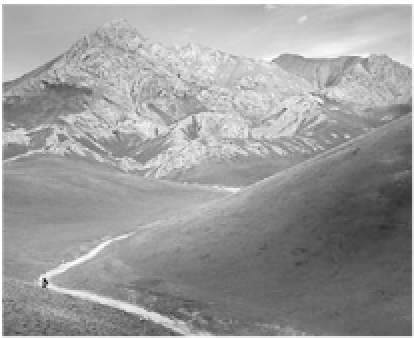Travel Reference
In-Depth Information
in the Hissar Mountains remains a mystery). Their leader eventually
yielded both the fortress and the beautiful Bactrian princess Roxana
(Roshanak), whom Alexander married in Balkh in 327 BC.
The brilliant Macedonian generalissimo's three-year sojourn in Cen-
tral Asia was marked by a growing megalomania. It was at Marakanda
(modern Samarkand) that Alexander murdered his right-hand general,
Cleitus. He tried to adopt the dress and autocratic court ritual of an Ori-
ental despot, until his Greek and Macedonian followers finally refused to
prostrate themselves before him.
When he died in Babylon in 323 BC, Alexander had no named heir
(despite fathering a son with Roxana). But his legacy included nothing
less than the West's perennial romance with exploration and expansion.
Alexander the
Great (Iskander
or Sikander) is
a popular figure,
after whom
several lakes
and mountains
are named.
His troops are
blamed for the
occasional blond-
haired, blue-eyed
Tajik, though this
is more likely the
result of Aryan
influence.
Eat Meets Wet
The aftermath of Alexander's short-lived Macedonian empire in Cen-
tral Asia saw an explosion of East-West cultural exchange and a chain
reaction of nomadic migrations. The Hellenistic successor states of the
Seleucid empire in Bactria disseminated the aesthetic values of the clas-
sical world deep into Asia. Hellenistic cities and Buddhist monasteries of
the 2nd century BC, such as Ai-Khanoum (Alexandria-Oxiana), Takht-i-
Sangin and Kobadiyan on the borders of Tajikistan, Uzbekistan and Af-
ghanistan (former Bactria), reveal a fascinating fusion of Greek, Persian
and local art forms. Ai-Khanoum boasted not only Greek-style baths, but
also a theatre and gymnasium, right on the banks of the Amu-Darya.
Several thousand kilometres east, along the border of Mongolia and
China, the expansion of the warlike Xiongnu (Hsiung-nu) confederacy
(probably the forebears of the Ephalites, or Huns) uprooted the Yuezhi of
western China. The Yuezhi (Yüeh-chih) were sent packing westward along
the Ili River into Saka (the borders of Kazakhstan and Kyrgyzstan), whose
displaced inhabitants in turn bore down upon the Sogdians to the south.
The Xiongnu were irritating more important powers than the Yuezhi.
Although protected behind its expanding Great Wall since about 250 BC,
China sought tranquillity on its barbarian frontier. In 138 BC, the Chinese
emperor sent a brave volunteer emissary, Zhang Qian, on a secret mission
to persuade the Yuezhi king to form an alliance against the Xiongnu.
When he finally got there, 13 years later, Zhang found that the Yu-
ezhi had settled down in Bactria/Tokharistan (southern Tajikistan and
northern Afghanistan) to a peaceable life of trade and agriculture, and
no longer had an axe to grind with the Xiongnu. But Zhang Qian's mis-
sion was still a great success of Chinese diplomacy and exploration, and
the stage had been set for the greatest of all East-West contacts: the birth
of the Silk Road.
The Sogdians
(from modern
Tajikistan and
Uzbekistan) were
the consummate
Silk Road traders,
so much so that
their language
became the
lingua franca of
the Silk Road.
105 BC
Parthia and China
exchange embassies
and inaugurate oicial
bilateral trade along
the caravan route that
lies between them. The
Silk Road is born.
AD 78-144
King Kanishka rules
the Kushan empire
from modern-day
Afghanistan. Buddhist
monasteries bloom in
southern Uzbekistan
and Tajikistan as the
irst human images of
Buddha are created.
¨
Silk Road, Kyrgyzstan









